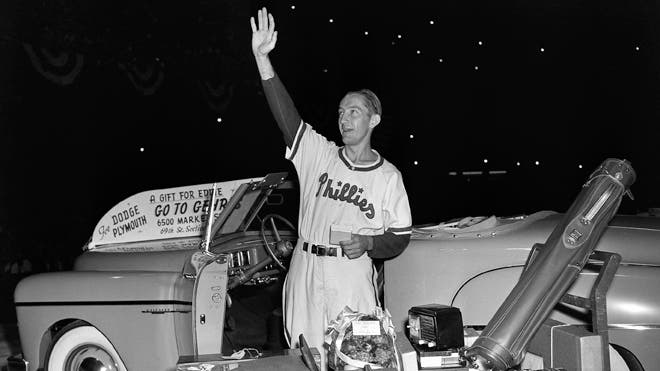Obsessed fan who shot player, inspired 'The Natural,' dies at 83
Published March 18, 2013
Associated Press
CHICAGO – She inspired a novel and a movie starring Robert Redford when in 1949 she lured a major league ballplayer she'd never met into a hotel room with a cryptic note and shot him, nearly killing him.
After the headlines faded, Ruth Ann Steinhagen did something else just as surprising: She disappeared into obscurity, living a quiet life unnoticed in Chicago until now, more than a half century later, when news broke that she had died three months earlier.
The Cook County Medical Examiner's Office confirmed Friday that Steinhagen passed away of natural causes on Dec. 29, at the age of 83. First reported by the Chicago Tribune last week, her identity was a surprise even to the morgue employees who knew about the 1984 movie "The Natural," in which she was portrayed by actress Barbara Hershey.
"She chose to live in the shadows and she did a good job of it," John Theodore, an author who wrote a 2002 nonfiction book about the crime, wrote in an email Sunday.
The story, with its elements of obsession, mystery, insanity and a baseball star, made it part of both Chicago's colorful crime history and rich baseball lore.
The story began with what appeared to be just another young woman's crush on Eddie Waitkus, the Chicago Cubs' handsome first baseman. So complete was this crush that the teenager set a place for Waitkus, whom she'd never met, at the family dinner table. She turned her bedroom into a shrine to him, and put his photo under her pillow.
After the 1948 season, Waitkus was traded to the Philadelphia Phillies — a fateful turn. "When he went to the Phillies, that's when she decided to kill him," Theodore said in an interview.
Steinhagen had her chance the next season, when the Phillies came to Chicago to play the Cubs at Wrigley Field. She checked into a room at the Edgewater Beach Hotel where he was staying and invited him to her room.
"We're not acquainted, but I have something of importance to speak to you about," she wrote in a note to him after a game at Wrigley on June 14, 1949.
It worked. Waitkus arrived at her room. After he sat down, Steinhagen walked to a closet, said, "I have a surprise for you," then turned with the rifle she had hidden there and shot him in the chest. Theodore wrote that she then knelt by his side and held his hand on her lap. She told a psychiatrist afterward about how she had dreamed of killing him and found it strange that she was now "holding him in my arms."
Newspapers devoured and trumpeted the lurid story of a 19-year-old baseball groupie, known in the parlance of the day as a "Baseball Annie." Among the sensational and probably staged photos was one showingSteinhagen writing in her journal at a table in her jail cell with a framed photograph of Waitkus propped nearby.
A judge determined she was insane and committed her to a mental hospital. She was released three years later, after doctors determined she had regained her sanity.
Details about the rest of her life are sketchy. She lived with her sister in a house just a few miles from the hotel where she shot Waitkus. A neighbor told Theodore that Steinhagen said she worked in an office for 35 years but never revealed her employer. And she made an effort to conceal her privacy, often refusing to answer the phone or come to the door when Theodore knocked.
Chris Gentner, a neighbor who used to help the Steinhagen sisters with chores, said he only found out who she was 15 years after they began living nearby.
"I found out through my ex-wife — I'm not sure how she found out — and I looked (Steinhagen) up online. And as soon as I saw (her photograph) online I said, 'That's her,'" Gentner said.
The 1984 movie was based on a novel by Bernard Malamud that was inspired by the story. Theodore's 2002 book was entitled "Baseball's Natural: The story of Eddie Waitkus."
Waitkus, who played the season after he was shot, helping the Phillies win the National League pennant, decided not to press charges in 1952 when Steinhagen was deemed sane. The trial would have likely made banner headlines — particularly since Malamud's novel was released in 1952 — so Watikus' decision almost certainly assisted Steinhagen's disappearance into obscurity.
He died in 1972, 12 years before Redford portrayed Roy Hobbs, the character inspired by Waitkus.
"He hardly ever talked to his family about Ruth," Theodore said.
Read more: http://www.foxnews.com/sports/2013/03/18/obsessed-fan-who-shot-player-inspired-natural-dies-at-83/#ixzz2NuRCgKfq
Waitkus was called "The Natural" early in his baseball career. He served with the U.S Army for four years during WWII in the Phillipines, etc. and was awarded four Bronze Medals. He spoke 4 languages. He suffered from PTSD after the shooting, and he died in 1972, shortly after turning 53.

No comments:
Post a Comment